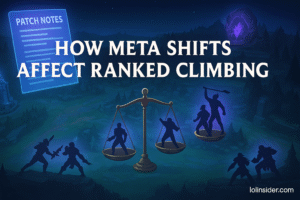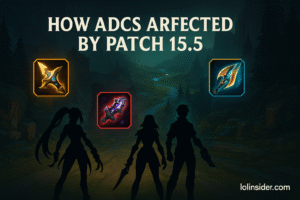Roaming is one of the highest-impact skills in League of Legends. Unlike farming or trading, roaming influences the entire map. Done right, it turns even lanes into advantages, secures objectives, and tilts enemy teams. Done poorly, it wastes time, costs CS, and leaves teammates exposed.
In this Guide to Roaming Effectively from Mid and Support, we’ll cover:
- The fundamentals of roaming.
- When and how to leave lane safely.
- Champion-specific roaming strengths.
- Pathing, vision, and synergy with your jungler.
- Pro-level roaming strategies with real-world examples.
By the end, you’ll understand how to roam effectively from mid and support and use it to control the pace of games.
1. What Is Roaming and Why It Matters
Roaming is leaving your assigned lane to influence another part of the map. The goal is to create pressure elsewhere without losing too much in your own lane.
Key benefits:
- Kill Pressure: Surprise ganks in top or bot lane.
- Objective Control: Help secure dragon, Rift Herald, or vision.
- Tempo Advantage: Force enemy laners to play safe, freeing your team.
- Psychological Pressure: If the enemy never knows where you are, they hesitate to push.
In pro play, entire games revolve around coordinated roams. In solo queue, mastering roams can turn you into the difference-maker.
2. Differences Between Mid and Support Roams
Roaming looks different depending on your role:
Mid Lane Roams
- Proximity advantage: Mid is closest to both side lanes.
- Timing: Roam after shoving wave.
- Typical champions: Twisted Fate, Galio, Sylas, Taliyah.
- Primary goal: Assist side lanes or collapse on jungle fights.
Support Roams
- Dependent on ADC: Can’t leave if ADC is vulnerable.
- Synergy with jungler: Most effective when pairing for invades or dragon setups.
- Typical champions: Nautilus, Thresh, Pyke, Rakan.
- Primary goal: Secure vision, coordinate ganks, protect map control.
3. When to Roam From Mid
Timing is everything. The best mid roams come when:
- Wave Priority: You’ve shoved your wave under enemy tower.
- Enemy Recall: If your opponent backs, you’re free to move.
- Objective Timers: Sync your roam with dragon/herald spawns.
- Jungle Collapses: Follow your jungler into river skirmishes.
- Summoner Spells: Punish bot lane when enemy Flash/Heal are down.
Pro Example: Faker’s Twisted Fate in international play — always shoving wave, then roaming with Destiny to create map-wide pressure.
4. When to Roam From Support
Supports must balance roaming with protecting their ADC. Good roam timings include:
- After a Bot Lane Crash: When you and your ADC push minions into tower.
- After Recall Sync: When both bot laners reset and wave resets.
- When ADC Safe: If your ADC can farm safely under tower.
- Early Level 2 Spikes: Champions like Nautilus or Thresh can roam immediately after hitting level 2.
- With Jungle Pathing: Pairing with your jungler for invades or scuttle fights.
Pro Example: Keria from T1 often leaves Gumayusi briefly to roam mid with Nautilus/Thresh, creating early 3v2 skirmishes.
5. Roaming Pathways
Understanding roaming routes is vital:
From Mid Lane
- Toward Bot Lane: The most common roam, punishing immobile ADCs.
- Toward Top Lane: Riskier, but impactful if enemy top is overextended.
- Into Jungle: Collapse on enemy camps or help invade.
From Support
- Bot to Mid: After wave crash, move mid to assist.
- Bot to River/Jungle: Secure dragon vision or pair with jungler.
- Bot to Top (Rare): Only in coordinated plays around Herald.
Key Tip: Always roam through areas you’ve warded — never walk blind into fog.
6. Champion Roaming Specialists
Some champions excel at roaming thanks to kit design:
Mid Lane Roamers
- Twisted Fate: Global pressure with Destiny.
- Galio: Hero’s Entrance enables instant cross-map fights.
- Sylas: Steals ultimates, thrives in skirmishes.
- Taliyah: Walling off enemies during roams.
Support Roamers
- Thresh: Hook + Lantern makes ganks lethal.
- Nautilus: Point-and-click CC for guaranteed picks.
- Rakan: Engage and disengage tools make him mobile.
- Pyke: Assassin support that thrives on roaming for kills.
7. Roaming Mistakes to Avoid
- Forcing Bad Roams: Don’t leave if your wave is crashing into your tower.
- Abandoning ADC: Roam only when ADC is safe.
- No Vision: Walking through unwarded jungle is suicide.
- Ignoring Enemy Roams: Sometimes your job is to counter-roam, not start one.
- Overstaying: Get a kill or burn summoners, then reset quickly.
8. Pro-Level Roaming Concepts
a) Roam Timing and Wave Management
Push wave → roam → return before losing more than one wave.
b) Roam With Purpose
Roam toward objectives (dragon/herald) instead of aimlessly searching for kills.
c) Disguised Roams
Walk into fog of war so enemies can’t instantly ping “missing.”
d) Counter-Roaming
Shadow the enemy mid/support when they roam. Even if no kill happens, you prevent their play from succeeding.
e) Cross-Map Trades
Sometimes you can’t stop a roam — so roam to the opposite side and trade objectives.
9. Training Drills to Improve Roaming
- Custom Game Drill: Practice wave clearing and leaving lane at optimal times.
- Replay Analysis: Watch your replays, pause at every potential roam timing.
- Pro Study: Focus on players like Chovy (mid) or Meiko (support) for roam timing.
- Communication Drill: In solo queue, spam ping your intentions early.
10. Regional Roaming Styles
- LCK: Calculated, objective-focused roams.
- LPL: Hyper-aggressive skirmish-heavy roams.
- LEC: Creative, often risky roams to snowball side lanes.
- LCS: Slower, safer roaming — often behind meta.
Conclusion
This Guide to Roaming Effectively from Mid and Support shows that roaming is about timing, coordination, and map awareness.
- Mid laners roam after wave priority, syncing with junglers and global ults.
- Supports roam after bot lane crashes, often to assist mid or set up vision.
- The best roams create objective pressure, not just kills.
Master roaming, and you’ll evolve from a lane-bound player into a map-wide playmaker — the type of teammate who dictates the pace of games and carries not just through mechanics, but through strategy.







